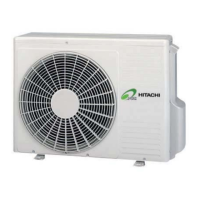REFRIGERANT PIPING & REFRIGERANT CHARGE
17
11.1. REFRIGERANT PIPING WORK
11.1.1. PIPING MATERIALS
1. Prepare locally-supplied copper pipes.
2. Select the piping size with the correct thickness and
correct material which can have sufficient pressure
strength.
3. Select clean copper pipes. Make sure there is no dust
and moisture inside. Blow the inside of the pipes with
oxygen free nitrogen to remove any dust and foreign
materials before connecting pipes.
4. After connecting the refrigerant piping, seal the open
space between Knockout hole and refrigerant pipes
by using insulation material as shown bellow:
NOTE:
A system with no moisture or oil contamination will
give maximum performance and lifecycle compared
to that of a poorly prepared system. Take particular
care to ensure all copper piping is clean and dry
internally.
There is no refrigerant in the cycle of the indoor unit.
CAUTION:
Cap the end of the pipe when pipe is to be inserted
through a hole
Do not put pipes on the ground directly without a cap
or vinyl tape at the end of the pipe
If piping installation is not completed until next day or
over a longer period of time, braze off the ends of the
piping and charge with oxygen free nitrogen through
a Schrader valve type access fitting to prevent
moisture and particle contamination.
Do not use insulation material that contains NH3
because it can damage cooper pipe material and can
be a source of future leakage.
Completely insulate both refrigerant gas piping and
liquid piping between the indoor unit(s) and the
outdoor unit.
If not insulated, dew will ocur on the piping surface
11.1.2. SUSPENSION OF REFRIGERANT PIPING
Suspend the refrigerant piping at certain points and prevent
the refrigerant piping from touching the weak part of the
building such as wall, ceiling, etc…
(If touched, abnormal sound may occur due to the vibration
of the piping. Pay special attention in case of short piping
length).
1~15m
Fire-Proof
Section
Treatment
Indoor Unit
Do not fix the refrigerant piping directly with the metal
fittings (The refrigerant piping may expand and contract).
Some examples for suspension method are shown below.
For Suspending Heavies
For Piping
Along The Wall
For Instant
Installation
Work
Insulate Pipes
After connecting the refrigerant piping, seal the refrigerant
pipes by using the field-supplied insulation material.
Insulate the unions and flare-nuts at the piping connections
completely. Insulate the liquid piping and gas piping
completely to avoid decreasing of performance and dewing
on the surface of the pipe.
Caution on Refrigerant Leakage
Specifiers/installers have responsibility to follow local codes
and regulation which specify safety requirements against
refrigerant leakage
Maximum Permissible Concentration of HCFC/HFC Gas
The refrigerant R410A, charged in the HVRN1 system, is
an incombustible and non-toxic gas. However, if leakage
occurs and gas fills a room, it may cause suffocation.
The maximum permissible concentration of HCFC/HFC
gas, R410A in air is 0.44 kg/m³, according to EN378-1
Therefore, some effective measure must be taken to lower
the R410A concentration in air below 0.44 kg/m³, in case of
leakage.
Insulation material
Field-Supplied
Insulation material
Insulation material
Unit
Side

